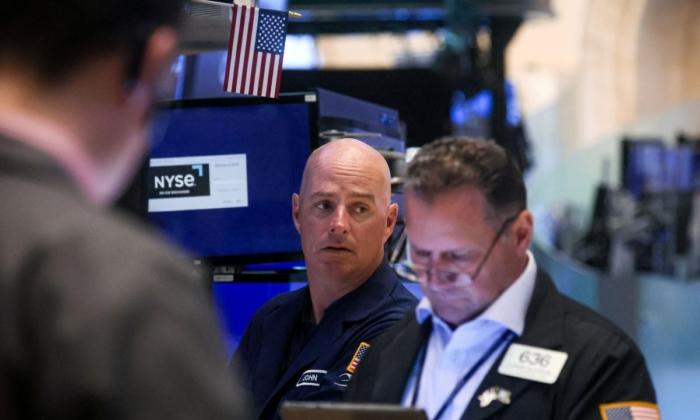Treasury yields popped following the hot September jobs report, forcing the futures market to boost the odds of the Federal Reserve raising interest rates at the next policy meeting of the Federal Open Market Committee (FOMC).
During the Oct. 6 trading session, the 2-year Treasury yield soared to an intraday high of 5.21 percent. The benchmark 10-year yield swelled to an intraday high of 4.862 percent. The 30-year Treasury yield crossed the 5 percent threshold before retreating to about 4.95 percent.
The 10- and 30-year Treasury securities touched their highest levels since August 2007.
The U.S. economy added 336,000 new jobs in September, topping the consensus estimate of 170,000. The unemployment rate was unchanged at 3.8 percent.
“In the short term, this will fuel fears of further inflationary pressures leading the Fed to hike again,” Giuseppe Sette, president of financial market research firm Toggle AI, said in a note. “In the mid-term, however, this is one more sign of a healthy economy that’s not showing signs of recession.”
It was the final jobs report before the FOMC holds its two-day policy meeting on Oct. 31 and Nov. 1.
This was the second piece of labor data last week to highlight a robust job market. Earlier this week, the Bureau of Labor Statistics reported that the number of job vacancies climbed to 9.6 million in August, triggering a fresh round of aggressive selling in the U.S. Treasury market.
According to the CME FedWatch tool, investors increased the chances of a 25 basis-point rate increase in November to 32 percent. Traders also bolstered the odds of a boost to the benchmark federal funds rate to almost 43 percent.
As a result of tighter monetary policy expectations, Treasury yields climbed to their best levels in more than a decade.
Reading the Treasury Tea Leaves
Yields of 7 percent may occur next year, warned Peter Schiff, the chief global strategist at Euro Pacific Capital.“Yields won’t stop rising at 5 percent, 6 percent, and 7 percent handles will likely follow in 2024, resulting in a financial crisis,” he wrote on X (formerly Twitter).
Bryce Doty, senior portfolio manager and senior vice president at Sit Investment Associates, thinks that the yield curve will “become nearly flat across all maturities soon and have an upward slope by year end.”
CNBC host Rick Santelli delivered a presentation on the business news network’s “Fast Money” program on Oct. 2 in which he warned that Treasury yields could peak longer term at 13 percent or 14 percent over the next 10 years, although he noted that there could be some pullback along the way.
James Knightley, chief international economist at ING, said that the September jobs report “keeps alive the prospect of another rate hike and certainly backs the Federal Reserve’s argument on the need for interest rates to stay higher for longer.”
Overall, the rising-rate climate could weigh on the financial markets in the home stretch of 2023, says John Lynch, the chief investment officer at Comerica Wealth Management.
Rate Hikes or Higher for Longer
Indeed, many central bank officials have expressed support for either another rate hike or leaving the policy rate higher for longer.Loretta Mester, president of the Federal Reserve Bank of Cleveland, told the 50 Club that the central bank may need to raise interest rates one more time this year.
“But whether the fed funds rate needs to go higher than its current level and for how long policy needs to remain restrictive will depend on how the economy evolves relative to the outlook,” Ms. Mester said in prepared remarks. “There is considerable uncertainty around the outlook.”
The annual inflation rate has reaccelerated for two consecutive months, climbing to 3.7 percent.
According to the Cleveland Fed’s Inflation Nowcast estimate, the September consumer price index (CPI) is expected to be unchanged at 3.7 percent. The October CPI is also anticipated to ease to 3.5 percent.
It will be “a long time” before the U.S. central bank cuts interest rates, Atlanta Fed Bank President Raphael Bostic said.
“I am not in a hurry to raise, I am not in a hurry to reduce either,” Mr. Bostic said at a Metro Atlanta Chamber event on Oct. 3.
The September Summary of Economic Projection (SEP), published at the latest FOMC meeting, indicates that the Fed is planning for one more rate increase before the year is finished, with the median rate forecast to come in at 5.6 percent. Officials left the fed funds rate unchanged at a range of 5.25 to 5.5 percent.
SEP data also show that the central bank expects smaller rate cuts late next year, with the Fed trimming the median policy rate by just 50 basis points.
Economists say that it will be a balancing act for the data-dependent Fed at the final two meetings of the year.







